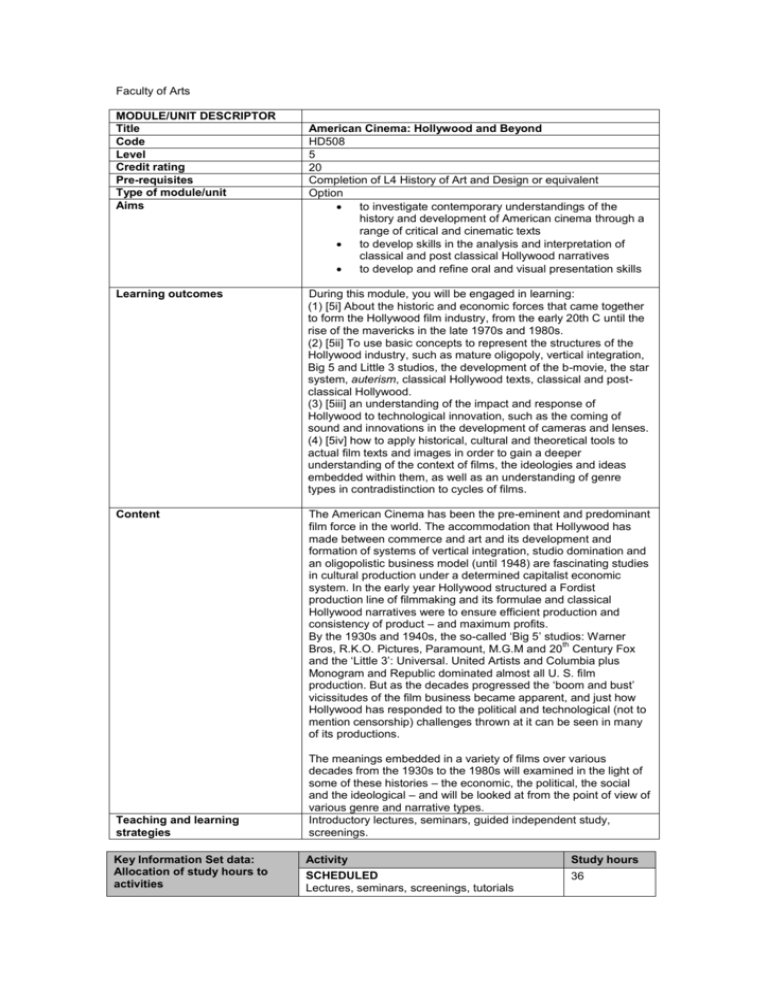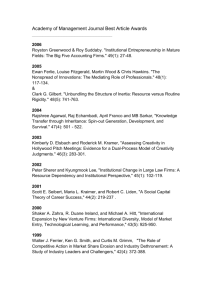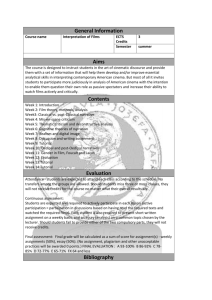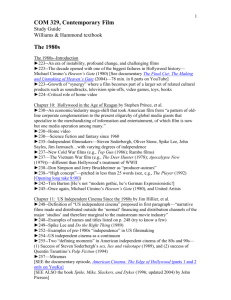HD508 American Cinema- Hollywood and Beyond
advertisement

Faculty of Arts MODULE/UNIT DESCRIPTOR Title Code Level Credit rating Pre-requisites Type of module/unit Aims American Cinema: Hollywood and Beyond HD508 5 20 Completion of L4 History of Art and Design or equivalent Option to investigate contemporary understandings of the history and development of American cinema through a range of critical and cinematic texts to develop skills in the analysis and interpretation of classical and post classical Hollywood narratives to develop and refine oral and visual presentation skills Learning outcomes During this module, you will be engaged in learning: (1) [5i] About the historic and economic forces that came together to form the Hollywood film industry, from the early 20th C until the rise of the mavericks in the late 1970s and 1980s. (2) [5ii] To use basic concepts to represent the structures of the Hollywood industry, such as mature oligopoly, vertical integration, Big 5 and Little 3 studios, the development of the b-movie, the star system, auterism, classical Hollywood texts, classical and postclassical Hollywood. (3) [5iii] an understanding of the impact and response of Hollywood to technological innovation, such as the coming of sound and innovations in the development of cameras and lenses. (4) [5iv] how to apply historical, cultural and theoretical tools to actual film texts and images in order to gain a deeper understanding of the context of films, the ideologies and ideas embedded within them, as well as an understanding of genre types in contradistinction to cycles of films. Content The American Cinema has been the pre-eminent and predominant film force in the world. The accommodation that Hollywood has made between commerce and art and its development and formation of systems of vertical integration, studio domination and an oligopolistic business model (until 1948) are fascinating studies in cultural production under a determined capitalist economic system. In the early year Hollywood structured a Fordist production line of filmmaking and its formulae and classical Hollywood narratives were to ensure efficient production and consistency of product – and maximum profits. By the 1930s and 1940s, the so-called ‘Big 5’ studios: Warner th Bros, R.K.O. Pictures, Paramount, M.G.M and 20 Century Fox and the ‘Little 3’: Universal. United Artists and Columbia plus Monogram and Republic dominated almost all U. S. film production. But as the decades progressed the ‘boom and bust’ vicissitudes of the film business became apparent, and just how Hollywood has responded to the political and technological (not to mention censorship) challenges thrown at it can be seen in many of its productions. Teaching and learning strategies Key Information Set data: Allocation of study hours to activities The meanings embedded in a variety of films over various decades from the 1930s to the 1980s will examined in the light of some of these histories – the economic, the political, the social and the ideological – and will be looked at from the point of view of various genre and narrative types. Introductory lectures, seminars, guided independent study, screenings. Activity Study hours SCHEDULED Lectures, seminars, screenings, tutorials 36 Where 10 credits = 100 learning hours GUIDED INDEPENDENT STUDY Independent study including wider reading and viewing practice, seminar presentations, completion of assessment tasks, etc. Learning support Indicative Bibliography: 164 Belton, J. American Cinema, American Culture (2008) Biskind, P. Seeing is Believing (1980) Bordwell, D., J. Steiger and K. Thompson, The Classical Hollywood Cinema (1994) Elsaesser, T. and W. Buckland, Studying Contemporary American Film (2002) Harris, M. Scenes From A Revolution: The Birth of the New Hollywood (2004) Maltby, R. Hollywood Cinema (2009) Assessment tasks Two 20-30 minute seminar presentations, each 25%, demonstrating learning outcomes 2 and 4 One extended essay of 3,500- 5,000 words (50%) demonstrating learning outcomes 1-4. Key Information Set data: Type of assessment tasks Summative assessment tasks which lead to the award of credit or which are required for progression (expressed as a whole number) Activity WRITTEN Written exam COURSEWORK Written assignment/ essay, report, dissertation, portfolio, project output PRACTICAL Oral assessment and presentation, practical skills assessment OTHER Set exercises assessing application of knowledge, analytical, problem-solving or evaluative skills % 50% 50% Brief description of module/unit content and/or aims (maximum 80 words) The American Cinema in the dominant form of Hollywood - and the attempts at creating alternative production systems- has been the basis of a worldwide cinematic dominance by the U.S. The accommodation that Hollywood has made between commerce and art and its development and formation of systems of vertical integration, studio domination and an oligopolistic business model are fascinating studies in cultural production under a determined capitalist economic system. The rise and fall of Hollywood’s fortunes and the emergence of ‘maverick’ cinema will be investigated from various points of view. Area examination board to which module/unit relates Module or unit team/ authors/coordinator Semester offered, where appropriate Site where delivered Date of first approval Date of last revision Date of approval of this version Version number Replacement for previous module/unit History of Art and Design James Evans Semester 1 or 2 Pavilion Parade 2010 2012 Field for which module/unit is acceptable and status in that field Course(s) for which module/unit is acceptable and status in that course School home External examiner Optional for all B.A. Programmes in History of Art and Design Humanities Nicholas Oddy (2011) Patrizia DiBello (2012) Caroline Pullee (2009)







